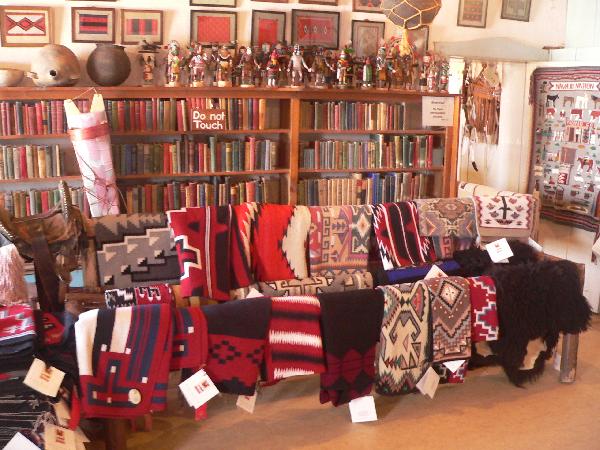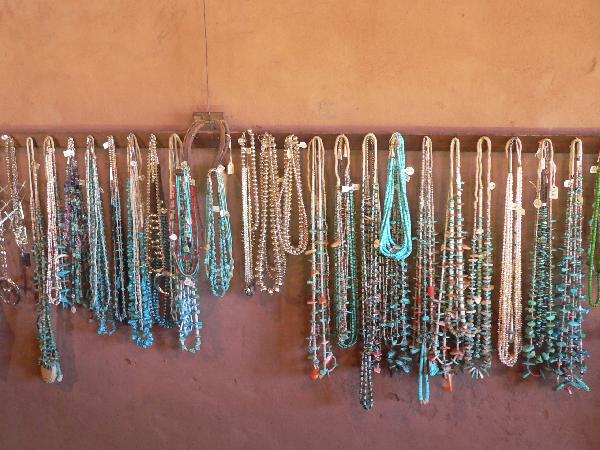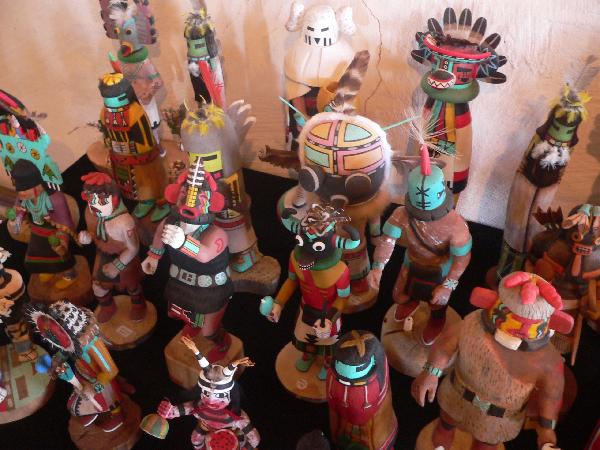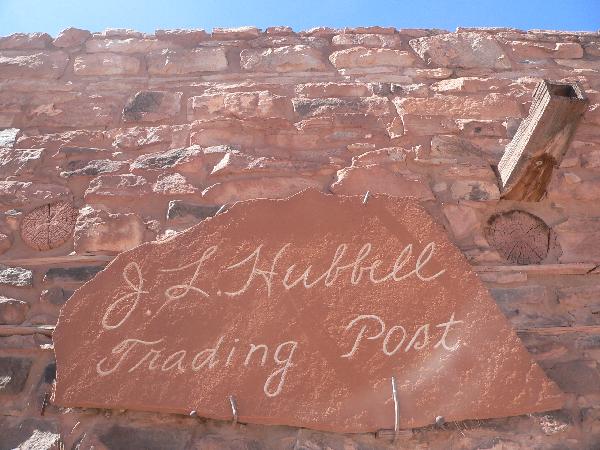NPS Website; Local Website
 WHAT IS IT?
WHAT IS IT?Began in 1876, Hubbell Trading Post is the oldest continuously run trading post in the Navajo Nation.
BEAUTY (7/10)
The Site’s beauty is derived not from its rather drab exterior and arid terrain but from its stunning traded goods and wares. The Trading Post is initially under whelming; you enter into a room whose counters line all three sides of the wall. Generic supermarket items are stacked on counters behind two salespeople. The community still buys its everyday goods here.
A doorway leads to the bounty for which the Hubbell Trading Post is known. Turquoise and silver jewelry, kachinas, Pima baskets, Hopi pottery and other veritable treasures of southwest Native art surround you. Intricately patterned and highly priced Navajo blankets lay scattered and unwatched on top of each other. Their rich colors and fine stitching belie their discarded look.
The store does not feel like an upscale Santa Fe boutique or a Gallup pawnshop. The Site’s historical feel is real and actually emits a comfortable shopping experience.
HISTORICAL INTEREST (6/10)
In name, the Hubbell Trading Post NHS seems to be about the fascinating John Lorenzo Hubbell. He was born in the southwest in 1853 to Connecticut parents, married into a Spanish family and started a series of trading posts in 1876. He ran dozens of posts throughout the southwest, spreading the art and culture of the Navajo worldwide. It is a testament to his good relations and high esteem among the Navajo that he and his family are the only non-Navajo that are buried in the vast Navajo Nation.
The real focus of the Site is the Navajo people, or in their words the Diné. Their blankets, baskets and art cover the walls of Hubbell’s house. The Diné goods for sale at the Post are the highlight of any visit. The Diné survive today in great numbers, hold more land than any Indian tribe partially because of their willingness to adapt their traditional weaving techniques to include non-native wools and dyes as well as intricate patterns.
 CROWDS (7/10)
CROWDS (7/10)The crowd was an interesting mix of tourists happening onto a strange, unknown place and locals purchasing a week’s worth of foods. By the time the house tour was over, we were all shoppers.
EASE OF USE/ACCESS (2/5)
The Hubbell Trading Post is located in the small town of Ganado, Ariz., 38 miles north of Interstate 40, Exit 333, along U.S. Route 191. Gallup, N.M. is 45 miles to the southeast and the Petrified Forest NP is 60 miles to the southwest.
CONCESSIONS/BOOKSTORE (5/5)
When the Park is, in fact, a store this rating should shine. The Hubbell Trading Post does not disappoint. To our untrained eyes, the collection of Navajo rugs, all accompanied by a Polaroid of its weaver holding the rug, rivaled the best shops in Santa Fe. The jewelry and woodcarvings kept us spellbound for a good amount of time. The store was more like an art gallery than a humble dusty trading post in the middle of nowhere.
The NPS bookstore, while not located in the Trading Post itself, is excellent. In addition to the free coffee, weaving demonstrations often occur here; the product then is sold in the bookstore. Over 20 titles deal specifically with Navajo rugs, weaving, and dyeing techniques.
Nearly all other books emphasize specifically the Diné, a rarity in southwestern Indian-related National Park Site. You will find Navajo-related books here that are sold at few other Sites and places in the United States.
For sale were conversational Navajo dictionaries, many profiles of the Navajo WWII code talkers, beautifully illustrated children’s books with one page written in English and the other in Navajo, mock Navajo rug mouse pads and reproductions of the red ink Navajo profiles that hang in Mr. Hubbell’s old house.
COSTS (5/5)
During our visit, the Site was free as were hourly Ranger tours of the Hubbell house. On May 1, 2005, the house tour will cost $2 per person. We enjoyed the free Arbuckle’s Coffee (the coffee that won the West) at the NPS visitor center.
RANGER/GUIDE TO TOURIST RATIO (4/5)
Ranger-led tours of the Hubbell House left every hour on the hour. Another Ranger was posted at the Visitor Center/bookstore ready to answer questions. While they were not Rangers, the Navajo salespeople at the Trading Post were more than helpful in explaining the treasures that were for sale.
 TOURS/CLASSES (7/10)
TOURS/CLASSES (7/10)The tour of the Hubbell house is a fascinating snapshot of calm amidst a time of historical storm. The house gives off an underlying feeling of both the Hubbell’s and the Diné’s mutual respect and love. The Navajo Ranger’s reverential tone towards the Hubbell’s and the house’s furnishings adds to the respectful mood.
The innumerable furnishings all tell countless stories. The walls, ceilings and floors are almost completely obscured by the paintings (mostly Indian portraits), rugs, baskets, books and furniture. The arrangements are haphazard and manic. Priceless baskets are nailed to the ceiling, rugs are draped for optimum use and paintings are hung without regard to spacing and sightlines. In other words, the house breathes life and an impetuousness grounded in learning.
Everything in the house is over 100 years old and they all have remarkable creation stories. Our Ranger kept the explanations at a minimum; if he hadn’t we could have been there all day.
There is no introductory video, but the Visitor Center offers 17 videos for your viewing pleasure. We wished we had watched the one explaining the Navajo weaving process. We regret that we did not learn much about that topic; there were no scheduled weaving demonstrations during our stay.
FUN (8/10)
When you have to wrap your feet in protective plastic booties before a house tour, you know you are going to see some cool things.
The Hubbell Trading Post NHS was a welcome respite to the mysteries and unknowns of most southwestern Indian sites. Here you see beautiful modern-day creations (albeit within an historical tradition) instead of “we have no idea what happened here” stone ruins.
Shopping in the Trading Post is also fun. It does not feel rushed and frenzied as it does with the street peddlers outside Santa Fe’s Palace of the Governors. Unlike the ritzy southwestern boutiques, you know the Navajo people create the product. We cannot attest to any bargains, but we had a great time browsing.
 WOULD WE RECOMMEND? (7/10)
WOULD WE RECOMMEND? (7/10)Most of the Indian sites in the American southwest are shrouded in mystery, entombed in vagaries and abstracts that are hard to understand. Too often NPS videos rely on stop-action photography of sky and desert and shadowed superimposed figures to try to explain what they do not know. Sites and ruins are beautiful but frustrating. Visitors are expected to understand that “this is a special place” and not expected to probe any further.
Not so at Hubbell Trading Post NHS. Touch the rugs and dolls that have given Navajo their strength. Talk to the weavers. Explore the rooms of Hubbell’s house filled with gifts from his friends and guests. Hubbell Trading Post is a concrete in an area full of abstracts. It was the one site that put us in touch with the community around us. And it was comfortable. No distinction was drawn between the tourist and the shopper, or the store and the historical site. The blending of modern necessities with traditional crafts, of community residents and travelers is something we think John Lorenzo Hubbell would approve.
TOTAL 58/80
www.usa-c2c.com
© 2004-06